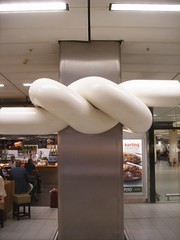March 05, 2013
Knotted whirlpools
 Finally a knotted vortex! Kleckner and Irvine describe in a Nature article how they managed to create a threefoil-shaped vortex by taking a threefoil band and accelerating it. The band has an airfoil cross-section, so when it starts moving it produces a local vortex line. New Scientist has an article and some videos.
Finally a knotted vortex! Kleckner and Irvine describe in a Nature article how they managed to create a threefoil-shaped vortex by taking a threefoil band and accelerating it. The band has an airfoil cross-section, so when it starts moving it produces a local vortex line. New Scientist has an article and some videos.
I have been longing for knotted vortices for years. It all began when I got The Inventions of Daedalus by David Jones. In one of the essays he suggests how to make knotted magnetic fields: sheath a flexible solenoid in superconductor tubing (so field lines cannot cross it). Make a knot on it. Turn on the power: now you have a normal magnetic field between the ends. Now untie the knot. Since the field lines will not intersect and cannot escape the superconductor tube the knot must end up on the magnetic field: between the poles of the solenoid there is now a knotted field.
This was mainly done in jest, of course. But I found it hard to see why it would not work (vector potentials don't have to be conservative). When I brought it up to Göran Grimvall he briefly handwaved it (probably because I, as a student, didn't explain it very clearly). However, it turns out that there are indeed real papers on magnetic knots. And, unsurprisingly, they are not really stable.
Getting a knotted vortex is in a sense the dual to the knotted magnetic field: if you have a knotted wire carrying a current it ought to produce a magnetic field that circulates like the fluid.
Posted by Anders3 at March 5, 2013 10:27 AM